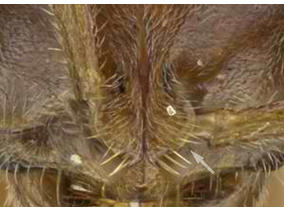TAXA (also search by using taxonomy search bar in header)
Hypoponera ragusai (Emery, 1894)
Nomenclature
SUMMARY
Hypoponera ragusai is a relatively nondescript small, shining brownish yellow to brown species with short antennal scapes and minute but conspicuous eyes. The species has often been referred to in the literature by its junior synonyms H. decipiens (Forel) and H. gleadowi (Forel), and has also been regularly misidentified as H. punctatissima (Bolton & Fisher, 2011). The native range of H. ragusai is in the Old World, and is conjectured to be of African origin (Wilson & Taylor, 1967). The current confirmed distribution includes Europe, Africa and India, though the actual distribution may be much wider. Like its close relative H. punctatissima, workers of the species are rarely collected and are likely restricted to the cryptobiotic subterranean and leaf litter habitats. It is likely that both species share a similar natural history. Taylor (1967)suggested that the production of ergatoid males by both H. punctatissima and its close relative H. ragusai (as H. gleadowi) may be related to their success as tramp species through some kind of simplification of nuptial activity. Although neither H. ragusai nor its synonyms are generally reported as a nuisance species, its pest status may require reevaluation in conjunction with its taxonomic status for material not examined by Bolton & Fisher (2011).
The worldwide distribution of H. ragusai will remain uncertain until material of the H. punctatissima group is reexamined according to the taxonomic changes and identification suggestions prescribed in Bolton & Fisher (2011). For example, H. gleadowi was reported as occurring in India, the Korean Peninsula, Japan, Taiwan, Hawaii and the continental U.S.A. (Imai et al., 2003), but the specimens should be checked against H. punctatissima before the distribution is confirmed. Wilson & Taylor (1967)treated H. decipiens as a junior synonym of H. punctatissima, and the material they assigned to the latter species from across the Pacific must also be reexamined to determine whether any of it belongs to H. ragusai (as does the Hawaii material (Onoyama, 1989)). The species is not believed to occur in Fiji (Sarnat & Economo, In Press). The records from Seychelles (Dorow, 1996), Saudi Arabia (Collingwood & Agosti, 1996)also await confirmation (Bolton & Fisher, 2011). Although not examined by Bolton & Fisher (2011), Ponera gyptis Santschi (syntypes from Maryland, USA) was synonymized with H. gleadowi (Taylor, 1967) and subsequently with H. ragusai by the previous authors.
Among Antkey species, H. ragusai is most likely to be confused with H. opaciceps and H. punctatissima. It can be reliably distinguished from the former by the antennal scapes which fail to reach the posterior head margin (versus reach and slightly exceed the posterior head margin), the more smooth and shining sculpture (especially the mesopleuron region), and the relatively shorter and broader petiole with the anterior and posterior faces slightly converging apically. It can be separated from H. punctatissima by (1) the petiolar node, which in profile is relatively longer and shorter (LPeI 55–61 versus 43–53 in H. punctatissima); and (2) in dorsal view the petiolar node is relatively shorter from front to back (DPeI 120–140 versus 140–165 in H. punctatissima). According to Bolton & Fisher (2011), in addition to differences in the shape of the petiolar node, H. ragusai workers are always yellow to light brownish yellow, fall at the bottom end of the known size range of H. punctatissima (e.g. HW 0.42–0.50, versus 0.46– 0.60 in H. punctatissima) and have heads that average relatively slightly narrower and scapes that are relatively slightly longer than in H. punctatissima; compare CI and SI above with CI 79–87 and SI 75–84 in H. punctatissima. Finally, the queen of H. ragusai is considerably darker in color than her workers, whereas in H. punctatissima the two castes have the same color.






